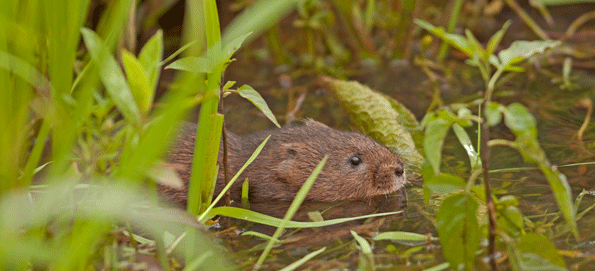
Ratty Returns (Sept 2012)
Water voles are now being spotted regularly at Moors Valley Country Park, near Ringwood thanks to the success of a long-term reintroduction programme initiated and overseen by Rangers from East Dorset Countryside Management Service.
The first water vole release in the Park took place last summer following an extensive period of riverbank clearance and monitoring for predatory mink. Their successful survival led to a second release last month, with 120 water voles joining those already established in the river systems, introducing new bloodlines and a boost to the existing population.
The project has involved a huge commitment in terms of time and effort. This has come not just from the Rangers, but also from the nine adjacent landowners, who have worked together to provide suitable habitats and crucially, monitor the rivers for mink activity.
The idea to reintroduce the water vole to Moors Valley Country Park was first conceived back in 2009. Local people fondly remembered sightings of Kenneth Graham’s iconic Wind in the Willows character in the Crane and Moors river system, and the Rangers were keen to bring ‘Ratty’ back to the Park. But with water vole populations struggling to survive across the country the conditions had to be exactly right.
“The water vole is Britain’s fastest declining mammal,” said Senior Countryside Ranger, Matt Reeks. “And that decline has been caused principally by loss of habitat and predation by North American mink.
“For a successful reintroduction we needed not only to ensure they had a suitable immediate habitat but also to monitor a wide area both inside and outside the Park to make sure we were not bringing the water vole to a river system where they would quickly be eaten by mink”.
The team were helped by the UK’s leading water vole conservation specialist and breeder, Derek Gow, and also benefited from the advice and experience of the Game & Wildlife Conservation Trust, the inventors of a simple but highly effective ‘mink raft’.
“Six thousand mink were released by animal activists from a local fur firm back in 1998 which had a huge impact on the local water vole population. We wanted to make sure our returning water voles would be safe,” said Matt. “The mink rafts have been designed to attract curious mammals, and once ‘on board’ they walk over a clay pad which very neatly records their tracks.”
Eleven rafts were built and positioned throughout the local river system enabling the Rangers to collect accurate evidence about the local mammal population. After a year of regular monitoring they knew the area was mink free, and the reintroduction could go ahead.
The mink rafts have also played an important role in confirming the survival of the first released population of water voles, regularly revealing the water voles’ distinctive star-shaped four-toed front foot. Otter tracks were also spotted regularly and there is good evidence that they will catch and kill mink. Otters will also eat the voles, but as they cannot enter the water vole burrows the two species can coexist and their presence is confirmation of the quality of both the water in the river system and riverbank habitat.
Whilst the mink rafts will continue to be monitored, Park visitors are now reporting their own water vole sightings to the Visitor Centre at Moors Valley, and the Rangers have also managed to take some photographs on both the river banks and in the water. Recent surveys have found some well-established colonies in some of the quieter areas of the Park.
“We really couldn’t be happier,” said Clare Gronow, Countryside Manager at Moors Valley. “As the third most visited country park in England we try to strike a careful balance between managing our visitors and ensuring our wildlife thrives. Of course it’s early days, but it’s wonderful to know that the water vole is now establishing itself again here at Moors Valley and that the work of so many people has been successful. As guardians of the Park we couldn’t be more pleased that we have been able to play a part in maintaining that rich biodiversity”.
For more information on the water vole programme and the full range of nature-based activities available at the Park contact the Rangers on 01425 470721 or visit www.moors-valley.co.uk.
Admission to the Park is free, parking charges apply.
ENDS
Word count: 706
Water Vole Fact File:
Latin name: Arvicola terrestri
Britain’s largest vole species
Britain’s fastest declining mammal: the national population is estimated at 400,000, a 1/3rd of the 1.2m estimate just 10 years ago.
Lifecycle: Average 5 month lifespan in the wild, 3 or 4 litters a year, averaging 5 to a litter, young voles are weaned at 14 days. Live in burrow complexes in river banks.
Vegetarian, 227 plants have been identified as part of the water vole diet.
Distinctive features: furry tail, hard to see the ears.
Spotters guide: watch for 4 toed star shape tracks. Listen for distinctive ‘plop’ as they launch themselves into the water.
Editors notes:
200 water voles were released into the Moors Valley river system in 2011. A further 120 were released in June 2012.
A selection of high res images are available in the press release images albumn.
Please call 01725 512200 or email amanda@phoenix-2.co.uk if you require more information.
